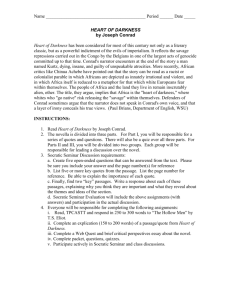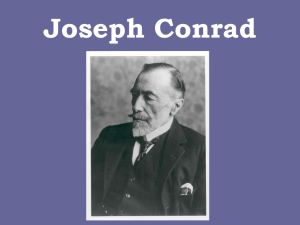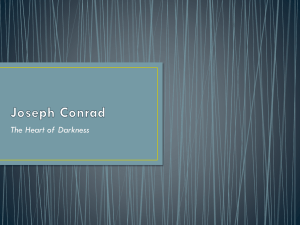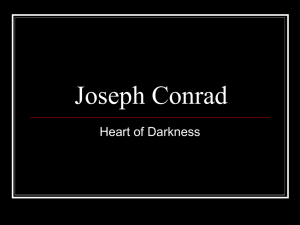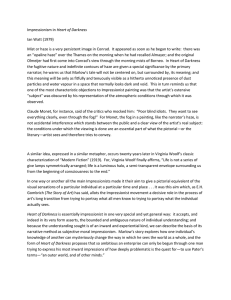EN123 – Modern World Literatures Seminar Tutor: Emilie Taylor-Brown
advertisement
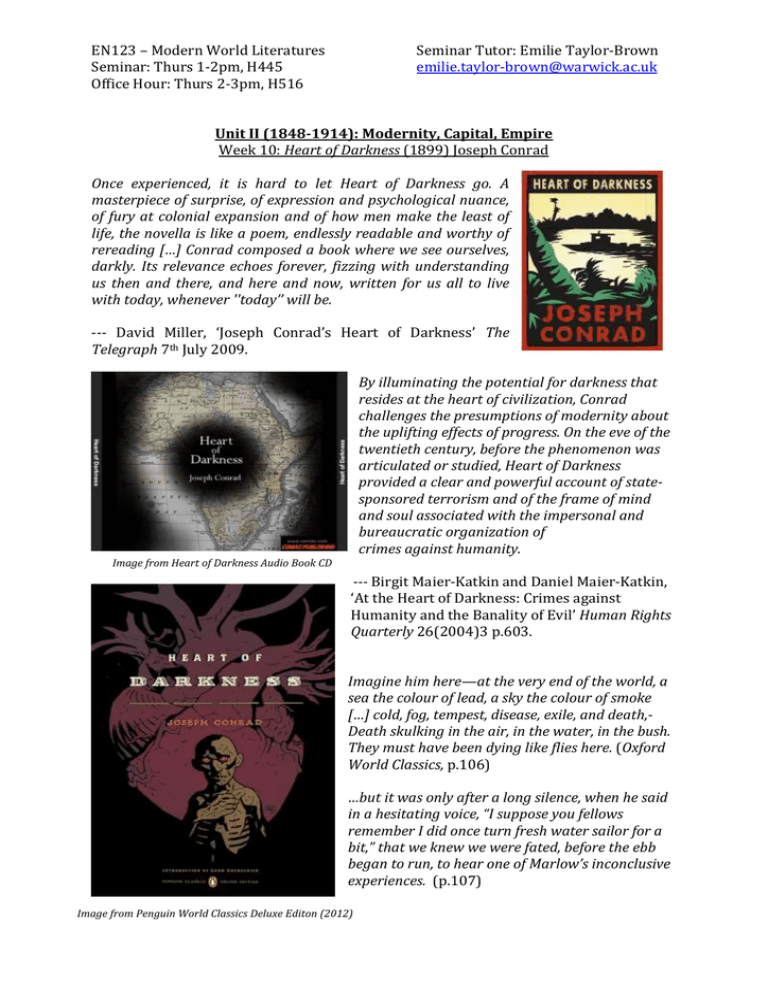
EN123 – Modern World Literatures Seminar: Thurs 1-2pm, H445 Office Hour: Thurs 2-3pm, H516 Seminar Tutor: Emilie Taylor-Brown emilie.taylor-brown@warwick.ac.uk Unit II (1848-1914): Modernity, Capital, Empire Week 10: Heart of Darkness (1899) Joseph Conrad Once experienced, it is hard to let Heart of Darkness go. A masterpiece of surprise, of expression and psychological nuance, of fury at colonial expansion and of how men make the least of life, the novella is like a poem, endlessly readable and worthy of rereading […] Conrad composed a book where we see ourselves, darkly. Its relevance echoes forever, fizzing with understanding us then and there, and here and now, written for us all to live with today, whenever ''today’’ will be. --- David Miller, ‘Joseph Conrad’s Heart of Darkness’ The Telegraph 7th July 2009. By illuminating the potential for darkness that resides at the heart of civilization, Conrad challenges the presumptions of modernity about the uplifting effects of progress. On the eve of the twentieth century, before the phenomenon was articulated or studied, Heart of Darkness provided a clear and powerful account of statesponsored terrorism and of the frame of mind and soul associated with the impersonal and bureaucratic organization of crimes against humanity. Image from Heart of Darkness Audio Book CD --- Birgit Maier-Katkin and Daniel Maier-Katkin, ‘At the Heart of Darkness: Crimes against Humanity and the Banality of Evil’ Human Rights Quarterly 26(2004)3 p.603. Imagine him here—at the very end of the world, a sea the colour of lead, a sky the colour of smoke […] cold, fog, tempest, disease, exile, and death,Death skulking in the air, in the water, in the bush. They must have been dying like flies here. (Oxford World Classics, p.106) …but it was only after a long silence, when he said in a hesitating voice, “I suppose you fellows remember I did once turn fresh water sailor for a bit,” that we knew we were fated, before the ebb began to run, to hear one of Marlow’s inconclusive experiences. (p.107) Image from Penguin World Classics Deluxe Editon (2012) EN123 – Modern World Literatures Seminar: Thurs 1-2pm, H445 Office Hour: Thurs 2-3pm, H516 Seminar Tutor: Emilie Taylor-Brown emilie.taylor-brown@warwick.ac.uk [At one end of the room] a large shining map, marked with all the colours of the rainbow. There was a vast amount of red – good to see at any time, because one knows that some real work is done in there, a deuce of a lot of blue, a little green, smears of orange, and, on the East Coast, a purple patch, to show where the jolly pioneers of progress drink the jolly larger-beer. However, I wasn’t going into any of these. I was going into the yellow. Dead in the centre. And the river there—fascinating—deadly—like a snake. (p.110) Going up that river was like travelling back to the earliest beginnings of the world, when vegetation rioted on the earth and the big trees were kings. An empty stream, a great silence, an impenetrable forest. The air was warm, thick, heavy, sluggish. There was no joy in the brilliance of the sunshine. The long stretches of the waterway ran on, deserted, into the gloom of overshadowed distances […] you lost your way on that river […] till you thought yourself bewitched and cut off for ever from everything you had known once— somewhere— far away—in another existence perhaps. (p.137) The Cerberus that guards the African Continent, its secrets, its mystery and its treasure is disease… (which I would liken to an insect). --- Patrick Manson, quoted by Sheldon Watts in ‘Yellow Fever, Malaria and Development: Atlantic Africa and the New World, 1647 to 1928’ Epidemics and History: Disease, Power and Imperialism (Bath: The Bath Press, 1997) p.213. Points to Consider: - How are London and the Thames characterised in relation to Africa and the Congo River? - What is the significance of the story-telling narration? - What role does disease play in the narrative? - How are the natives depicted? - Consider the inconsistencies of the tenses in the novella; what significance does this have? i.e. the ambiguous distinction between direct speech and narration/Marlow’s thoughts and interpretations versus conversations he is relating. - Consider the Faustian parallels e.g. ‘I let him run on, this papier-maché Mesphistopheles, and it seemed to me that if I tried I could poke my forefinger through him’ (p.128) - How does the depiction of African nature contribute to the image of the ‘dark continent’? From the semi-autobiographical primal scene in which Marlow first registers the “blank spaces” on the map of Africa to his participation in the darkening work of imperialist exploration, Conrad creates a micro- cosmic vision of modernity in Heart of Darkness […Conrad posits incipient global capitalism as the horizon of the social organization by making the Company, rather than any nation, the chief power in the land. This last move drives home the implications of the ideologically- motivated constructedness of this social EN123 – Modern World Literatures Seminar: Thurs 1-2pm, H445 Office Hour: Thurs 2-3pm, H516 Seminar Tutor: Emilie Taylor-Brown emilie.taylor-brown@warwick.ac.uk organization by focusing on the Company’s power as the origin, arbiter, and executor of the law. Starting with the Company’s ability to create an entire class of “criminals” by discursive fiat, Conrad repeatedly draws our attention to how such constructions not only displace people and despoil landscapes, but actually alter individual identities and reconfigure subjectivities. --- Stephen Ross, ‘Desire in Heart of Darkness’ Conradiana 36(2004)1-2 p.76. Mr Kurtz lacked restraint in the gratification of his various lusts, that there was something wanting in him—some small matter which, when the pressing need arose, could not be found under his magnificent eloquence. Whether he knew of this deficiency himself I can’t say. I think the knowledge came to him at the last— only at the very last. But the wilderness had found him out early, and had taken on him a terrible vengeance for the fantastic invasion. I think it had whispered to him things about himself which he did not knew, things of which he had no conception till he took counsel with this great solitude— and the whisper had proved irresistibly fascinating. It echoed loudly with him because he was hollow at the core… (p.165) Further Reading: Bloom, H. (ed), Bloom’s Modern Critical Interpretations: Heart of Darkness—New Edition (New York: Infobase Publishing, 2008) especially: Said, E. ‘Two Visions in Heart of Darkness’ Peters, J. ‘The Opaque and the Clear: The White Fog Incident in Conrad’s “Heart of Darkness” Elliott, D.W. ‘Hearing the Darkness: The Narrative Chain in Conrad's Heart of Darkness’ English Literature in Transition, 1880-1920, 28(1985)2 pp.162-181. Hampson, R. Conrad’s Secrets (Palgrave Macmillan, 2012) [electronic resource] Maier-Katkin, B. and Maier-Katkin, D. ‘At the Heart of Darkness: Crimes against Humanity and the Banality of Evil’ Human Rights Quarterly 26(2004)3 pp.584604. Paris, B. J. Conrad’s Charlie Marlow; A New Approach to Heart of Darkness and Lord Jim (Palgrave Macmillan, 2006) [electronic resource] Ross, S. ‘Desire in Heart of Darkness’ Conradiana 36(2004)1-2 pp.65-86. Schmitt, C. ‘Tidal Conrad (Literally)’ Victorian Studies 55(2012)1 pp.8-27.
